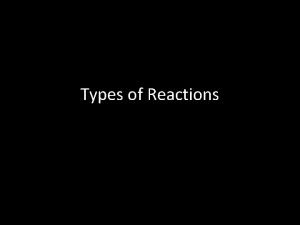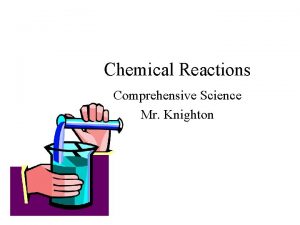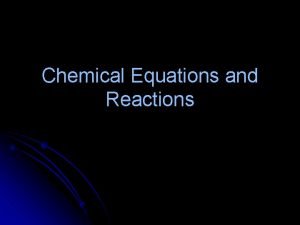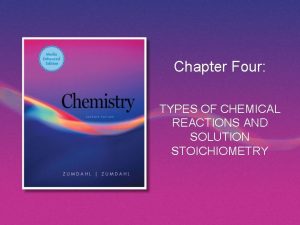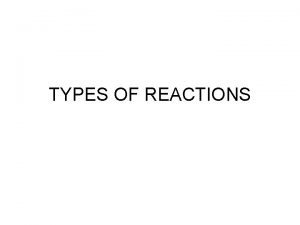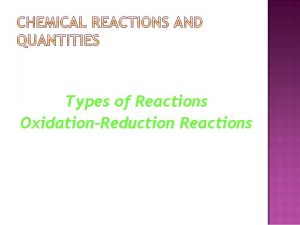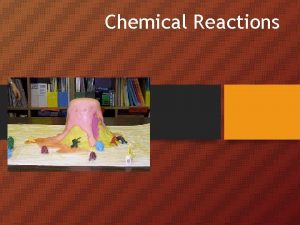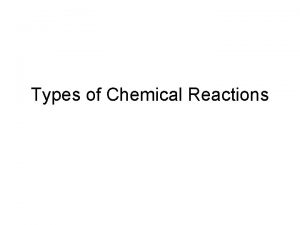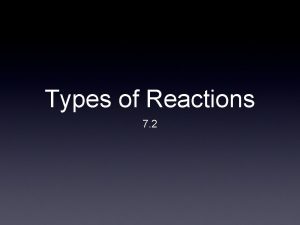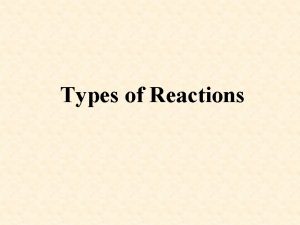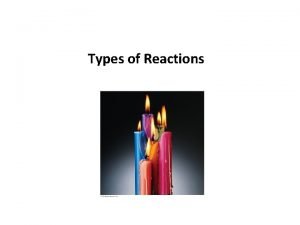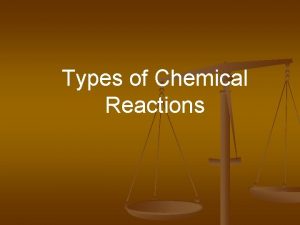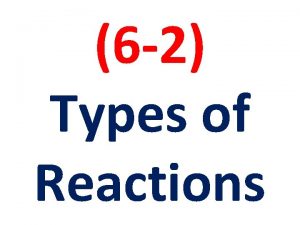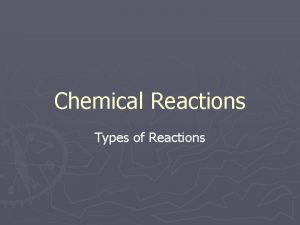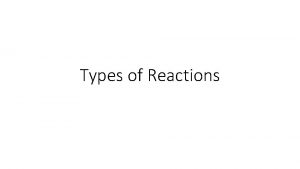Reactions and Types Example 1 What is produced























- Slides: 23

Reactions and Types


Example 1 What is produced below? C 3 H 8(g) + O 2(g) → CO 2(g) + H 2 O(g) Now balance! C 3 H 8(g) +5 O 2(g) → 3 CO 2(g) + 4 H 2 O(g)

Combustion • Combustion means burning, usually in oxygen but sometimes with other oxidants such as fluorine • oxidant is a reactant that oxidizes or removes electrons from other reactants • A combustion reaction happens quickly, producing heat, and usually light and fire • When solving these reactions it helps to work through the carbon first

Combustion So what is produced? C 6 H 12 O 6(s) + O 2(g) → CO 2(g) + H 2 O(g) Balance C 6 H 12 O 6(s) + 12 O 2(g) → 6 CO 2(g) + 6 H 2 O(g)

Synthesis In this photo of Los Angeles, California, the air over the city is brown with smog. A major component of smog is nitrogen dioxide, which is a toxic gas with a sharp odor. Nitrogen dioxide can irritate the eyes and throat and trigger asthma attacks. Where does this poisonous gas come from? It forms when nitric oxide—from sources such as car exhaust— reacts with oxygen in the air. This reaction is a synthesis reaction.

Synthesis reaction • synthesis reaction occurs when two or more reactants combine to form a single product. A synthesis reaction can be represented by the general equation: • A+B→C • letters A and B represent the reactants that begin the reaction, and the letter C represents the product that is synthesized in the reaction • arrow shows the direction in which the reaction occurs.

• Q: What is the chemical equation for the synthesis of nitrogen dioxide (NO 2) from nitric oxide (NO) and oxygen (O 2)? • A: The equation for this synthesis reaction is: 2 NO + O 2 → 2 NO 2

New type

What is the color of the bottle that hydrogen peroxide is in? Brown Why? It breaks down (decomposes) from light Reaction: H 2 O 2(aq) → H 2 O(l) + O 2(g) 2 H 2 O 2(aq) -> 2 H 2 O(l) + O 2(g)

Decomposition • decomposition reaction is a reaction in which a compound breaks down into two or more simpler substances. The general form of a decomposition reaction is: • AB→A+B • Most decomposition reactions require an input of energy in the form of heat, light, or electricity.


Replacement Reaction • A replacement reaction occurs when elements switch places in compounds. This type of reaction involves ions (electrically charged versions of atoms) and ionic compounds • Two Types • Single Replacement Reaction • Double Replacement Reaction

Single Replacement Most Reactive • A single replacement reaction occurs when one element replaces another in a single compound • You can predict whether a single-displacement reaction will occur by comparing the reactivity of an element using an activity series table • A metal can displace any metal lower in the activity series (cations) • The same rule applies to halogens (anions) : H most reactive and At least reactive Least Reactive

Activity Series • Reactivity series: series of metals, in order of reactivity from highest to lowest • Used to determine the products of single displacement reactions, where by: metal A will replace another metal B in a solution if A is higher in the series

Practice Problems for metals Use the activity series to predict the products, if any, of each equation. • (add this problem to your notes) Li(s) + Ag+(aq) → ? Lithium is more reactive (higher in the series), so it will replace silver in the aqueous solution. Ag(s) + Li+(aq) 1. Fe. Cl 2 + Zn → ? Because zinc is above iron in the activity series, it will replace iron in the compound. The products of this single-replacement reaction are Zn. Cl 2 + Fe 1. Na. NO 3 + Au → ? Gold is below Sodium in the activity series. As such, it will not replace hydrogen in a compound with the nitrate ion. No reaction is predicted.

Practice Problems for Halogens Will a single-replacement reaction occur? If so, identify the products. • Mg. Cl 2 + I 2 → ? Because iodine is below chlorine on the periodic table, a single -replacement reaction will not occur. • Ca. Br 2 + F 2 → ? Because fluorine is above bromine on the periodic table, a single-replacement reaction will occur, and the products of the reaction will be Ca. F 2 + Br 2

Double Replacement • Double-replacement reaction: a reaction in which the positive and negative ions of two ionic compounds exchange places to form two new compounds • General form of a double-replacement (also called doubledisplacement) reaction is: • AB+CD→AD+BC • Example: 2 KI(aq) + Pb(NO 3)2(aq) → 2 KNO 3(aq) + Pb. I 2(s)

Solubility Rules • When a substance is mixed with a solvent, there are several possible results • A solute is defined as the substance that is dissolved in a solution (solvent) • Soluble- dissolves, aqueous (aq) • Insoluble- Does not dissolve, solid (s)

Solubility Rules

Solubility Effects on Reactions • Depending on the solubility of a solute, there are three possible results: 1) if the solution has less solute than the maximum amount that it is able to dissolve (its solubility), it is a dilute solution 2) if the amount of solute is exactly the same amount as its solubility, it is saturated 3) if there is more solute than is able to be dissolved, the excess solute separates from the solution. • If this separation process includes crystallization, it forms a precipitate • Precipitation lowers the concentration of the solute to the saturation in order to increase the stability of the solution

Problems 1. Is Fe. CO 3 soluble (will it dissolve)? carbonates tend to be insoluble. Therefore, Fe. CO 3 is likely to form a precipitate. • 2. Does Na. Cl. O 4 tend to form a precipitate? This is perchlorate, likely to be soluble. Sodium salts are soluble it will not form a precipitate. Na. Cl. O 4 -> Na+ + Cl. O 4 -

Problems 3. Which of these substances is likely to form a precipitate? a) Ca. SO 4 b) table salt c) Ag. Br Letters a and c are both likely to form precipitates a) Ca. SO 4, although sulfates tend to be soluble, Rule #5 indicates that calcium sulfate is an important exception to this rule. b), Rule #1 indicates that table salt (Na. Cl) is soluble because it is a salt of an alkali metal. c) is an example of two rules contradicting each other. Rule #4 states that bromides are usually soluble, but Rule #3 states that salts of silver are insoluble. Because Rule #3 precedes Rule #4, the compound is insoluble and will form a precipitate.
 Section 2 classifying chemical reactions
Section 2 classifying chemical reactions Reduction half reaction
Reduction half reaction Section 2 classifying chemical reactions worksheet answers
Section 2 classifying chemical reactions worksheet answers Types of reactions
Types of reactions Unit 5 chemical reactions answers
Unit 5 chemical reactions answers Types of chemical reactions and solution stoichiometry
Types of chemical reactions and solution stoichiometry Types of chemical reactions and solution stoichiometry
Types of chemical reactions and solution stoichiometry Different types of redox reactions
Different types of redox reactions Types of reaction
Types of reaction Types of reactions
Types of reactions Different types of reactions
Different types of reactions Types of reactions chemistry
Types of reactions chemistry How to identify type of reaction
How to identify type of reaction 4 types of chemical reactions
4 types of chemical reactions Co 60
Co 60 Four types of chemical reactions
Four types of chemical reactions 5 types of reactions chemistry
5 types of reactions chemistry 5 general types of chemical reactions
5 general types of chemical reactions 5 general types of chemical reactions
5 general types of chemical reactions Types of reactions chemistry
Types of reactions chemistry What are the 4 types of chemical reactions
What are the 4 types of chemical reactions Four types of chemical reactions
Four types of chemical reactions What is the type of reaction
What is the type of reaction Two types of nuclear reactions
Two types of nuclear reactions










